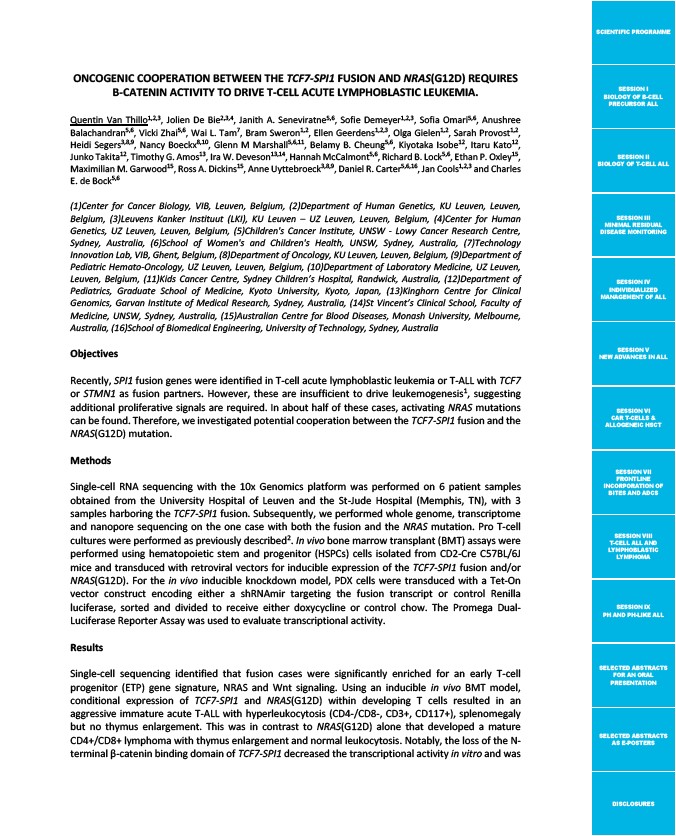
SCIENTIFIC PROGRAMME
SESSION I
BIOLOGY OF B-CELL
PRECURSOR ALL
SESSION II
BIOLOGY OF T-CELL ALL
SESSION III
MINIMAL RESIDUAL
DISEASE MONITORING
SESSION IV
INDIVIDUALIZED
MANAGEMENT OF ALL
SESSION V
NEW ADVANCES IN ALL
SESSION VI
CAR T-CELLS &
ALLOGENEIC HSCT
SESSION VII
FRONTLINE
INCORPORATION OF
BITES AND ADCS
SESSION VIII
T-CELL ALL AND
LYMPHOBLASTIC
LYMPHOMA
SESSION IX
PH AND PH-LIKE ALL
SELECTED ABSTRACTS
FOR AN ORAL
PRESENTATION
SELECTED ABSTRACTS
AS E-POSTERS
DISCLOSURES
ONCOGENIC COOPERATION BETWEEN THE TCF7-SPI1 FUSION AND NRAS(G12D) REQUIRES
Β-CATENIN ACTIVITY TO DRIVE T-CELL ACUTE LYMPHOBLASTIC LEUKEMIA.
Quentin Van Thillo1,2,3, Jolien De Bie2,3,4, Janith A. Seneviratne5,6, Sofie Demeyer1,2,3, Sofia Omari5,6, Anushree
Balachandran5,6, Vicki Zhai5,6, Wai L. Tam7, Bram Sweron1,2, Ellen Geerdens1,2,3, Olga Gielen1,2, Sarah Provost1,2,
Heidi Segers3,8,9, Nancy Boeckx8,10, Glenn M Marshall5,6,11, Belamy B. Cheung5,6, Kiyotaka Isobe12, Itaru Kato12,
Junko Takita12, Timothy G. Amos13, Ira W. Deveson13,14, Hannah McCalmont5,6, Richard B. Lock5,6, Ethan P. Oxley15,
Maximilian M. Garwood15, Ross A. Dickins15, Anne Uyttebroeck3,8,9, Daniel R. Carter5,6,16, Jan Cools1,2,3 and Charles
E. de Bock5,6
(1)Center for Cancer Biology, VIB, Leuven, Belgium, (2)Department of Human Genetics, KU Leuven, Leuven,
Belgium, (3)Leuvens Kanker Instituut (LKI), KU Leuven – UZ Leuven, Leuven, Belgium, (4)Center for Human
Genetics, UZ Leuven, Leuven, Belgium, (5)Children's Cancer Institute, UNSW - Lowy Cancer Research Centre,
Sydney, Australia, (6)School of Women's and Children's Health, UNSW, Sydney, Australia, (7)Technology
Innovation Lab, VIB, Ghent, Belgium, (8)Department of Oncology, KU Leuven, Leuven, Belgium, (9)Department of
Pediatric Hemato-Oncology, UZ Leuven, Leuven, Belgium, (10)Department of Laboratory Medicine, UZ Leuven,
Leuven, Belgium, (11)Kids Cancer Centre, Sydney Children’s Hospital, Randwick, Australia, (12)Department of
Pediatrics, Graduate School of Medicine, Kyoto University, Kyoto, Japan, (13)Kinghorn Centre for Clinical
Genomics, Garvan Institute of Medical Research, Sydney, Australia, (14)St Vincent’s Clinical School, Faculty of
Medicine, UNSW, Sydney, Australia, (15)Australian Centre for Blood Diseases, Monash University, Melbourne,
Australia, (16)School of Biomedical Engineering, University of Technology, Sydney, Australia
Objectives
Recently, SPI1 fusion genes were identified in T-cell acute lymphoblastic leukemia or T-ALL with TCF7
or STMN1 as fusion partners. However, these are insufficient to drive leukemogenesis1, suggesting
additional proliferative signals are required. In about half of these cases, activating NRAS mutations
can be found. Therefore, we investigated potential cooperation between the TCF7-SPI1 fusion and the
NRAS(G12D) mutation.
Methods
Single-cell RNA sequencing with the 10x Genomics platform was performed on 6 patient samples
obtained from the University Hospital of Leuven and the St-Jude Hospital (Memphis, TN), with 3
samples harboring the TCF7-SPI1 fusion. Subsequently, we performed whole genome, transcriptome
and nanopore sequencing on the one case with both the fusion and the NRAS mutation. Pro T-cell
cultures were performed as previously described2. In vivo bone marrow transplant (BMT) assays were
performed using hematopoietic stem and progenitor (HSPCs) cells isolated from CD2-Cre C57BL/6J
mice and transduced with retroviral vectors for inducible expression of the TCF7-SPI1 fusion and/or
NRAS(G12D). For the in vivo inducible knockdown model, PDX cells were transduced with a Tet-On
vector construct encoding either a shRNAmir targeting the fusion transcript or control Renilla
luciferase, sorted and divided to receive either doxycycline or control chow. The Promega Dual-
Luciferase Reporter Assay was used to evaluate transcriptional activity.
Results
Single-cell sequencing identified that fusion cases were significantly enriched for an early T-cell
progenitor (ETP) gene signature, NRAS and Wnt signaling. Using an inducible in vivo BMT model,
conditional expression of TCF7-SPI1 and NRAS(G12D) within developing T cells resulted in an
aggressive immature acute T-ALL with hyperleukocytosis (CD4-/CD8-, CD3+, CD117+), splenomegaly
but no thymus enlargement. This was in contrast to NRAS(G12D) alone that developed a mature
CD4+/CD8+ lymphoma with thymus enlargement and normal leukocytosis. Notably, the loss of the N-terminal
β-catenin binding domain of TCF7-SPI1 decreased the transcriptional activity in vitro and was